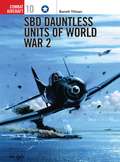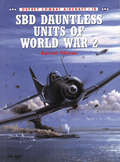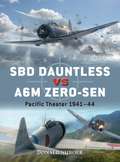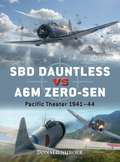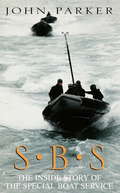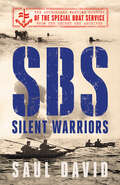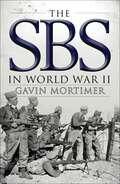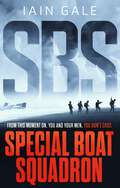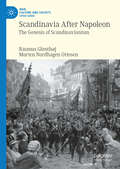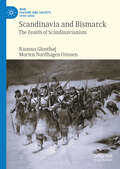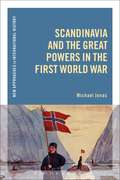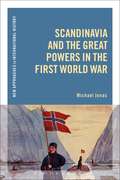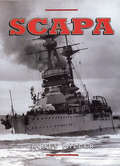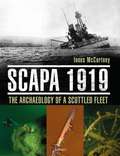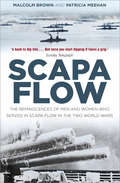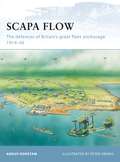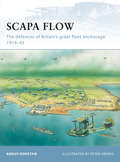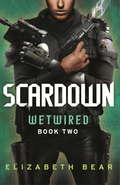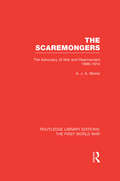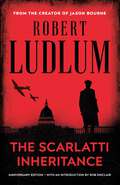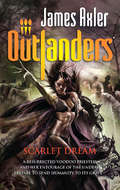- Table View
- List View
SBD Dauntless Units of World War 2 (Combat Aircraft)
by Barrett Tillman Tom TullisUnquestionably the most successful dive-bomber ever to see frontline service with any air arm, the Douglas SBD Dauntless was the scourge of the Japanese Imperial Fleet in the crucial years of the Pacific War. The revolutionary all-metal stressed-skin design of the SBD exhibited airframe strength that made it an ideal dive-bomber, its broad wing, with horizontal centre section and sharply tapered outer panels with dihedral, boasting perforated split flaps that doubled as dive brakes during the steep bombing attacks
SBD Dauntless Units of World War 2 (Combat Aircraft #10)
by Barrett Tillman Tom TullisUnquestionably the most successful dive-bomber ever to see frontline service with any air arm, the Douglas SBD Dauntless was the scourge of the Japanese Imperial Fleet in the crucial years of the Pacific War. The revolutionary all-metal stressed-skin design of the SBD exhibited airframe strength that made it an ideal dive-bomber, its broad wing, with horizontal centre section and sharply tapered outer panels with dihedral, boasting perforated split flaps that doubled as dive brakes during the steep bombing attacks
SBD Dauntless vs A6M Zero-sen: Pacific Theater 1941–44 (Duel)
by Donald NijboerThe SBD Dauntless dive-bomber was a key cog in the US Navy's aerial arsenal throughout the Pacific War. Although a product of aviation design in the mid to late 1930s, the type soldiered on even as more advanced aircraft were appearing from American factories as the war progressed. Despite its classification as a dive-bomber and rather dated appearance, the SBD Dauntless could more than handle its own against the feared A6M Zero-sen – a regular opponent, especially during the first 18 months of the campaign in the Pacific. The SBD was credited with 138 victories in aerial combat (principally in 1942), 107 of which were fighters and the rest bombers. Seven SBD units claimed five or more aerial victories, with future ace Lt(jg) John Leppla of VS-2 being credited with four victories while flying from the carrier USS Lexington during the Battle of the Coral Sea in May 1942. The Zero-sen came to symbolise Japan's military prowess during the early stages of the war in the Pacific, and it quickly became the world's premier carrier-based fighter – a title it would hold well into 1943. The psychological impact of the Zero-sen was so great that all Allied fighters were judged by the standards set by it. The aviators flying the A6M in 1941-42 were amongst the most experienced fighter pilots in the world, and they claimed a significant number of the SBDs destroyed while trying to defend their carriers from attack during the Battles of Coral Sea, Midway and Santa Cruz in 1942. While one was a dive-bomber and the other a nimble fighter, both met in combat many times, with the Dauntless proving an elusive and deadly target thanks to the tenacity and skill of the pilots and gunners manning the Douglas aircraft. While the Zero-sen was credited with shooting down many SBDs, the rugged dive-bomber gave as good as it got and emerged, not surprisingly, victorious on many occasions.This book examines these aircraft in detail, exploring their history and development and contains accurate descriptions of the combats between the SBD Dauntless and Zero-sen throughout the first four carrier battles of 1942 and the Solomons Campaign.
SBD Dauntless vs A6M Zero-sen: Pacific Theater 1941–44 (Duel #115)
by Donald NijboerThe SBD Dauntless dive-bomber was a key cog in the US Navy's aerial arsenal throughout the Pacific War. Although a product of aviation design in the mid to late 1930s, the type soldiered on even as more advanced aircraft were appearing from American factories as the war progressed. Despite its classification as a dive-bomber and rather dated appearance, the SBD Dauntless could more than handle its own against the feared A6M Zero-sen – a regular opponent, especially during the first 18 months of the campaign in the Pacific. The SBD was credited with 138 victories in aerial combat (principally in 1942), 107 of which were fighters and the rest bombers. Seven SBD units claimed five or more aerial victories, with future ace Lt(jg) John Leppla of VS-2 being credited with four victories while flying from the carrier USS Lexington during the Battle of the Coral Sea in May 1942. The Zero-sen came to symbolise Japan's military prowess during the early stages of the war in the Pacific, and it quickly became the world's premier carrier-based fighter – a title it would hold well into 1943. The psychological impact of the Zero-sen was so great that all Allied fighters were judged by the standards set by it. The aviators flying the A6M in 1941-42 were amongst the most experienced fighter pilots in the world, and they claimed a significant number of the SBDs destroyed while trying to defend their carriers from attack during the Battles of Coral Sea, Midway and Santa Cruz in 1942. While one was a dive-bomber and the other a nimble fighter, both met in combat many times, with the Dauntless proving an elusive and deadly target thanks to the tenacity and skill of the pilots and gunners manning the Douglas aircraft. While the Zero-sen was credited with shooting down many SBDs, the rugged dive-bomber gave as good as it got and emerged, not surprisingly, victorious on many occasions.This book examines these aircraft in detail, exploring their history and development and contains accurate descriptions of the combats between the SBD Dauntless and Zero-sen throughout the first four carrier battles of 1942 and the Solomons Campaign.
SBS: Inside Story Of Special Boat Service
by John ParkerThe men of the SBS are the maritime equivalent of their counterparts in the SAS; they are the elite of the British Special Forces and also the most secretive. Although SAS activity has been extensively documented, the SBS has remained in the state it prefers - a shadowy silhouette, with identities protected and missions kept from public view. Formed during the Second World War, when they took part in many daring raids (one of which was filmed as The Cockleshell Heroes), they were active in the jungle campaigns in the Far East, in the Falklands, the Gulf War and Bosnia. Since this seminal book was published in 1997, John Parker has been privy to much more inside information about the SBS's original operations and he brings the book right up to date with accounts of their exploits in East Timor, Somalia, Sierra Leone, Kosovo and most recently in Iraq.
SBS – Silent Warriors: The Authorised Wartime History
by Saul David‘It is incredibly refreshing to read of these fabulously daring missions … This is a terrific book, written with all the gusto, thrills and heady excitement these SBS operations richly deserve. It really is one of the most enjoyable histories I’ve read in many a year’ James Holland, Daily Telegraph, five stars
The SBS in World War II: An Illustrated History
by Gavin MortimerThe Special Boat Squadron was Britain's most exclusive Special Forces unit during World War II. Highly trained, totally secretive and utterly ruthless, the SBS was established as an entity in its own right in early 1943, having previously operated under the auspices of the SAS during the war in North Africa. Unlike its sister unit, which numbered more than 1,000 men, the SBS never comprised more than 100. Led by men such as the famed Victoria Cross recipient Anders Lassen, the SBS went from island to island in the Mediterranean, landing in the dead of night in small fishing boats and launching savage hit and run raids on the Germans. By the end of the war they had served in Italy, the Balkans and mainland Greece, and following the cessation of hostilities their deeds were airbrushed out of history by an establishment that had never warmed to their piratical exploits. Through unrivalled access to the SBS archives and interviews with the surviving members of the unit, Gavin Mortimer has pieced together the dramatic exploits of this elite fighting force, fully illustrated with images of their daring actions, finally granting the unit the recognition they so richly deserved.
The SBS in World War II: An Illustrated History (General Military Ser.)
by Gavin MortimerThe Special Boat Squadron was Britain's most exclusive Special Forces unit during World War II. Highly trained, totally secretive and utterly ruthless, the SBS was established as an entity in its own right in early 1943, having previously operated under the auspices of the SAS during the war in North Africa. Unlike its sister unit, which numbered more than 1,000 men, the SBS never comprised more than 100. Led by men such as the famed Victoria Cross recipient Anders Lassen, the SBS went from island to island in the Mediterranean, landing in the dead of night in small fishing boats and launching savage hit and run raids on the Germans. By the end of the war they had served in Italy, the Balkans and mainland Greece, and following the cessation of hostilities their deeds were airbrushed out of history by an establishment that had never warmed to their piratical exploits. Through unrivalled access to the SBS archives and interviews with the surviving members of the unit, Gavin Mortimer has pieced together the dramatic exploits of this elite fighting force, fully illustrated with images of their daring actions, finally granting the unit the recognition they so richly deserved.
SBS: Special Boat Squadron
by Iain GaleA historical adventure chronicling the exploits of the Special Boat Squadron, the seaborne raiders who, by strength and guile, carried out World War Two's most daring covert operations.From this moment on, you and your men, you don't exist. Formed in the darkest hours of the Second World War, as nation after nation fell before the unstoppable Axis advance, the task of the SBS was to strike back at an enemy no army could meet in the field. Trained in sabotage and surveillance, the Special Boat Squadron raided deep behind enemy lines, sowing chaos and capturing much-needed intelligence. Soldiers, adventurers and rogues, their methods were unorthodox, their success rate unprecedented.Operation Anglo, 31 August 1942.Beneath the waves of the Mediterranean, HMS Traveller closes in on the coast of Rhodes. Aboard, eight SBS commandos check their weapons as they prepare to infiltrate and sabotage two Axis bomber fields. Only two of the eight commandos will make it back to alive. Ex-Black Watch Sgt Jim Hunter will be one of the lucky ones, but what he will face next will make Operation Anglo look like a cakewalk.Reviewers on Iain Gale:'A fast fit fighting yarn that transports you to the deadly hillsides of wartime Crete.' Quentin Letts on SBS 'A powerful novel of men at war. A triumph.' Bernard Cornwell on Four Days in June 'Very exciting.' Daily Telegraph on the Jack Steele series
Scandinavia After Napoleon: The Genesis of Scandinavianism (War, Culture and Society, 1750–1850)
by Rasmus Glenthøj Morten Nordhagen OttosenThis book explores the intellectual grounds of Scandinavianist ideology and its political development into a national unification movement. Denmark, Norway and Sweden were nearly annihilated during the Napoleonic Wars. The lesson learned was that survival was a matter of size. Whereas their union of 1814 offered Sweden-Norway geostrategic security tempered by fear of Russia, Denmark was the biggest territorial loser of the Napoleonic Wars and faced separatism connected to German nationalism in the duchies of Schleswig and Holstein. This evolved into a national conflict that threatened Denmark’s survival as a nation. Meanwhile, a new generation of Danes, Swedes and Norwegians had come to regard kindred language, culture and religion as a case for Scandinavian union that could offer protection against Russia and Germany. When the European revolutions of 1848 unleashed the First Schleswig War, the influence of Scandinavianism was such that it nearly turned into a Scandinavian war of unification.
Scandinavia and Bismarck: The Zenith of Scandinavianism (War, Culture and Society, 1750–1850)
by Rasmus Glenthøj Morten Nordhagen OttosenThis book accounts for Scandinavian unification efforts in a time of great upheaval. The ideological repercussions of the European revolutions of 1848-1849 and the Crimean War (1853-1856) transformed both the international political system and nationalism into more ‘realist’ types. The First Schleswig War (1848-1851) having nearly turned into one of Scandinavian unification, the influence of Scandinavianism extended into the Danish, Swedish and Norwegian courts, cabinets and parliaments, attracting interest from the great powers. The Crimean War offered another window of opportunity for Scandinavian unification, before the Danish-German conflict over the duchies of Schleswig and Holstein nearly united Scandinavia upon the outbreak of the Second Schleswig War in 1864. The ultimate failure of Scandinavianism in its unification efforts was not predetermined, although historiography has made it appear as such. Napoleon III, Cavour and Bismarck all actively contributed to plans for Scandinavian unification, the latter even declaring himself as “very strongly Scandinavian”.
Scandinavia and the Great Powers in the First World War (New Approaches to International History)
by Michael JonasThis study is among the first works in English to comprehensively address the Scandinavian First World War experience in the larger international context of the war. It surveys the complex relationship between the belligerent great powers and Northern Europe's neutral small states in times of crisis and war.The book's overreaching rationale draws upon three underlying conceptual fields: neutrality and international law, hegemony and great power politics as well as diplomacy and policy-making of small states in the international arena. From a variety of angles, it examines the question of how neutrality was understood and perceived, negotiated and dealt with both among the Scandinavian states and the belligerent major powers, especially Britain, Germany and Russia.For a long time, the experience of neutral countries during the First World War was seen as marginal, and was overshadowed by the experiences of occupation and collaboration brought about by the Second World War. In this book, Jonas demonstrates how this perception has changed, with neutrality becoming an integral part of the multiple narratives of the First World War. It is an important contribution to the international history of the First World War, cultural-historically influenced approaches to diplomatic history and the growing area of neutrality studies.
Scandinavia and the Great Powers in the First World War (New Approaches to International History)
by Michael JonasThis study is among the first works in English to comprehensively address the Scandinavian First World War experience in the larger international context of the war. It surveys the complex relationship between the belligerent great powers and Northern Europe's neutral small states in times of crisis and war.The book's overreaching rationale draws upon three underlying conceptual fields: neutrality and international law, hegemony and great power politics as well as diplomacy and policy-making of small states in the international arena. From a variety of angles, it examines the question of how neutrality was understood and perceived, negotiated and dealt with both among the Scandinavian states and the belligerent major powers, especially Britain, Germany and Russia.For a long time, the experience of neutral countries during the First World War was seen as marginal, and was overshadowed by the experiences of occupation and collaboration brought about by the Second World War. In this book, Jonas demonstrates how this perception has changed, with neutrality becoming an integral part of the multiple narratives of the First World War. It is an important contribution to the international history of the First World War, cultural-historically influenced approaches to diplomatic history and the growing area of neutrality studies.
Scapa
by Jim Miller'a fascinating book, in which every reader will find something she/he never knew' - Scots Magazine 'an interesting insight into life in a naval base during two world wars' - Broadly Boats Scapa Flow, one of the greatest naval bases in history, resonates through the annals of the Royal Navy during the two great wars of the twentieth century. It was from there that the Grand Fleet sailed to Jutland in 1916; from there that Russian convoys set off; and it was in that beautiful, bleak anchorage that the German High Seas fleet committed the greatest act of suicide ever seen at sea - 'The Grand Scuttle' - before being raised and scrapped in one of the most astonishing examples of maritime salvage. It was also in Scapa that we have our last photographs of Kitchener before he boarded the Hampshire, sunk by mine off Marwick Head. But it was also in this great anchorage that many more human stories took place. Here lie the wrecks - now war graves - of the Vanguard, blown apart by an explosion in 1917 and the Royal Oak, sunk by Gunther Prien of U-47 in a spectacular raid at the beginning of World War Two. Here too Italian prisoners of war built both the spectacular Churchill causeways and the exquisite Italian chapel at Lamb Holm crafted from Nissan huts. The text weaves eyewitness accounts and personal experience into the larger narrative, and the photographs capture the spirit and activity of Scapa Flow when it was the home of thousands of service personnel.
Scapa 1919: The Archaeology of a Scuttled Fleet
by Innes McCartneyThe German High Seas Fleet was one of the most powerful naval forces in the world, and had fought the pride of the Royal Navy to a stalemate at the battle of Jutland in 1916. After the armistice was signed, ending fighting in World War I, it surrendered to the British and was interned in Scapa Flow pending the outcome of the Treaty of Versailles. In July 1919 the entire fleet attempted to sink itself in the Flow to prevent it being broken up as war prizes. Of the 74 ships present, 52 sunk and 22 were prevented from doing so by circumstance and British intervention. Marine archaeologist and historian Dr Innes McCartney reveals for the first time what became of the warships that were scuttled, examining the circumstances behind the loss of each ship and reconciling what was known at the time to what the archaeology is telling us today. This fascinating study reveals a fleet lost for nearly a century beneath the waves.
Scapa 1919: The Archaeology of a Scuttled Fleet
by Innes McCartneyThe German High Seas Fleet was one of the most powerful naval forces in the world, and had fought the pride of the Royal Navy to a stalemate at the battle of Jutland in 1916. After the armistice was signed, ending fighting in World War I, it surrendered to the British and was interned in Scapa Flow pending the outcome of the Treaty of Versailles. In July 1919 the entire fleet attempted to sink itself in the Flow to prevent it being broken up as war prizes. Of the 74 ships present, 52 sunk and 22 were prevented from doing so by circumstance and British intervention. Marine archaeologist and historian Dr Innes McCartney reveals for the first time what became of the warships that were scuttled, examining the circumstances behind the loss of each ship and reconciling what was known at the time to what the archaeology is telling us today. This fascinating study reveals a fleet lost for nearly a century beneath the waves.
Scapa Flow: The Reminiscences of Men and Women Who Served in Scapa Flow in the Two World Wars
by Malcolm Brown Patricia MeehanScapa Flow, a vast, natural harbour in the Orkney Islands, served as the Royal Navy’s main base during the two world wars, from where ships sailed to the Battle of Jutland in the First and in convoy to northern Russia in the Second. Thousands of men and women saw service in and around this remote anchorage, including soldiers and sailors who crewed the ships and manned the lonely batteries, and Wrens, nurses and civilians who were posted there. Scapa Flow brings together their memories – the bleak isolation, its implacable winds and glorious sunsets, the camaraderie and good humour – forming a compelling portrait of a unique war station that left its mark on all who served there.
Scapa Flow: The defences of Britain’s great fleet anchorage 1914–45 (Fortress)
by Peter Dennis Angus KonstamA strategically important natural harbor in the Orkney Islands, Scapa Flow served as Britain's main fleet anchorage during World Wars I and II. In 1914 and again in 1939, the British began building a comprehensive defensive network by fortifying the entrances to Scapa Flow, and then extended these defenses to cover most of Orkney. By 1940, it had become an island fortress, the largest integrated defensive network of its kind in Europe, manned by as many as 50,000 Commonwealth troops. Backed by newly commissioned artwork, naval historian Angus Konstam tells the story of this mighty naval fortress, many pieces of which can still be seen on the island today.
Scapa Flow: The defences of Britain’s great fleet anchorage 1914–45 (Fortress #85)
by Peter Dennis Angus KonstamA strategically important natural harbor in the Orkney Islands, Scapa Flow served as Britain's main fleet anchorage during World Wars I and II. In 1914 and again in 1939, the British began building a comprehensive defensive network by fortifying the entrances to Scapa Flow, and then extended these defenses to cover most of Orkney. By 1940, it had become an island fortress, the largest integrated defensive network of its kind in Europe, manned by as many as 50,000 Commonwealth troops. Backed by newly commissioned artwork, naval historian Angus Konstam tells the story of this mighty naval fortress, many pieces of which can still be seen on the island today.
Scardown: Book Two (Jenny Casey #2)
by Elizabeth BearThe year is 2062, and after years on the run, Jenny Casey is back in the Canadian armed forces. Those who were once her enemies are now her allies, and at fifty, she's been handpicked for the most important mission of her life - a mission for which her artificially reconstructed body is perfectly suited. With the earth capable of sustaining life for just another century, Jenny - as pilot of the starship Montreal - must discover brave new worlds. And with time running out, she must succeed where others have failed.Now Jenny is caught in a desperate battle where old resentments become bitter betrayals and justice takes the cruelest forms of vengeance. With the help of a brilliant AI, an ex-crime lord, and the man she loves, Jenny may just get her chance to save the world. If it doesn't come to an end first . . .
The Scaremongers: The Advocacy of War and Rearmament 1896-1914 (Routledge Library Editions: The First World War)
by A. J. MorrisThis revealing book illustrates how the passion for war was fostered and promoted. The author provides detailed evidence of how and why an image of Germany as a nation determined upon world hegemony was deliberately promoted by a group of British newspaper editors, proprietors and journalists. This book examines the role of these ‘scaremongers’. Were they as influential as their critics claimed? Did they influence the minds of their readers and shape events? Were they guilty of creating a climate of opinion that ensured that their prophecies of inevitable Anglo-German war became fact in 1914?
The Scaremongers: The Advocacy of War and Rearmament 1896-1914 (Routledge Library Editions: The First World War)
by A. J. MorrisThis revealing book illustrates how the passion for war was fostered and promoted. The author provides detailed evidence of how and why an image of Germany as a nation determined upon world hegemony was deliberately promoted by a group of British newspaper editors, proprietors and journalists. This book examines the role of these ‘scaremongers’. Were they as influential as their critics claimed? Did they influence the minds of their readers and shape events? Were they guilty of creating a climate of opinion that ensured that their prophecies of inevitable Anglo-German war became fact in 1914?
The Scarlatti Inheritance: Action, adventure, espionage and suspense from the master storyteller (Mini-hardbacks Ser.)
by Robert LudlumIncludes a new introduction from bestselling author Rob SinclairThe Third Reich is in its death struggle...A spellbinding story of international terror and intrigue, greed and cunning, suspense and murder from the No. 1 bestselling master storyteller.'The real titan of the genre is Robert Ludlum' GQ'THE SCARLATTI INHERITANCE has drive and excitement from first page to last. Robert Ludlum is an ingenious storyteller' Mario PuzoIn Washington, word is received that an elite member of Nazi High Command is willing to defect and divulge information that will shorten the war. But his defection entails the release of the ultra top-secret file on the Scarlatti Inheritance - a file whose contents will destroy many of the Western world's greatest and most illustrious reputations if they are made known...
The Scarlet Contessa: A Novel Of The Italian Renaissance
by Jeanne KalogridisFrom Jeanne Kalogridis, critically acclaimed author of The Borgia Bride, Painting Mona Lisa and The Devil’s Queen, comes another irresistible historical novel about a countess whose passion and willfulness knew no bounds: Caterina Sforza.
Scarlet Dream
by James AxlerThe poisonous alien race masterminding centuries of calculated chaos and destruction for mankind underestimated the sheer tenacity of the human spirit. Now these technologically superior aggressors must contend with a dedicated group of warriors sworn to reclaim their planet. The odds against the Cerberus rebels are long, but the fight goes on.…
